RBSE Solutions for Class 8 Maths Chapter 6 Square and Square Roots Ex 6.4
Rajasthan Board RBSE Solutions for Class 8 Maths Chapter 6 Square and Square Roots Ex 6.4 Textbook Exercise Questions and Answers.
RBSE Class 8 Maths Solutions Chapter 6 Square and Square Roots Ex 6.4
Question 1.
Find the square root of each of the following numbers by division method :
(i) 2304
Answer:
Division Method:
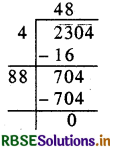
∴ \(\sqrt{2304}\) = 48
(ii) 4489
Answer:
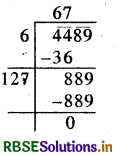
∴ \(\sqrt{4489}\) = 67
(iii) 3481
Answer:

∴ \(\sqrt{3481}\) = 59
(iv) 529
Answer:
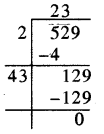
∴ \(\sqrt{529}\) = 23
(v) 3249
Answer:

∴ \(\sqrt{3249}\) = 57

(vi) 1369
Answer:
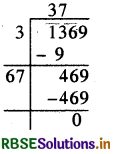
∴ \(\sqrt{1369}\) = 37
(vii) 5776
Answer:
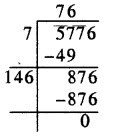
∴ \(\sqrt{5776}\) = 76
(viii) 7921
Answer:
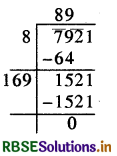
∴ \(\sqrt{7921}\) = 89
(ix) 576
Answer:

∴ \(\sqrt{576}\) = 24
(x) 1024
Answer:
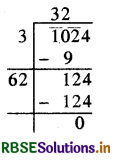
∴ \(\sqrt{1024}\) = 32
(xi) 3136
Answer:
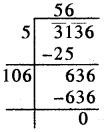
∴ \(\sqrt{3136}\) = 56
(xii) 900
Answer:
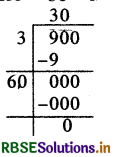
∴ \(\sqrt{900}\) = 30

Question 2.
Find the number of digits in the square root of each of the following numbers (without any calculation).
(i) 64
Answer:
We know that if a perfect square of n-digits, then its square root will have \(\frac{n}{2}\) digits if n is even and \(\frac{(n+1)}{2}\) digits if n is odd.
Given number is 64. It is a 2-digit number,
i. e., even number of digits.
∴ The number of digits in \(\sqrt{64}\) is \(\left(\frac{2}{1}\right)\) i.e., 1.
(ii) 144
Answer:
The given number is 144. It is a 3-digit number, i.e., odd number of digits.
∴ \(\sqrt{144}\) contains \(\left(\frac{3+1}{2}\right)\); i.e., 2 digits.
(iii)4489
Answer:
Given number is 4489. It is a 4-digit number, i.e., even number of digits.
∴ \(\sqrt{4489}\) contains \(\left(\frac{4}{2}\right)\), i.e. 2 digits.
(iv) 27225
Answer:
Given number is 27225. It is a number, i.e., odd number of digits.
∴ \(\sqrt{27225}\) contains \(\left(\frac{5+1}{2}\right)\), i.e. 3 digits.
(v) 390625
Answer:
Given number is 390625. It is a 6-digit number, i.e. even number of digits.
∴ \(\sqrt{390625}\) contains \(\left(\frac{6}{2}\right)\), i.e. 3 digits.

Question 3.
Find the square root of the following decimal numbers.
(i) 2.56
Answer:
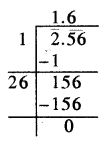
∴ \(\sqrt{2.56}\) = 1.6
(ii) 7.29
Answer:
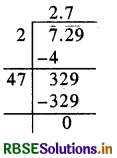
∴ \(\sqrt{7.29}\) = 2.7
(iii) 51.84
Answer:
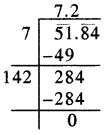
∴ \(\sqrt{51.84}\) = 7.2
(iv) 42.25
Answer:
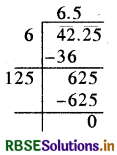
∴ \(\sqrt{42.25}\) = 6.5
(v) 31.36
Answer:

∴ \(\sqrt{31.36}\) = 5.6
Question 4.
Find the least number which must be subtracted from each of the following numbers so as to get a perfect square. Also find the square root of the perfect square so obtained.
(i) 402
Answer:
First, we try to find the square root of 402.
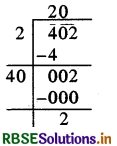
This shows that (20)2 is less than 402 by 2. So in order to get a perfect square, 2 must be subtracted from the given number.
∴ Required perfect square number
= 402 - 2 = 400
Also, \(\sqrt{400}\) = 20

(ii) 1989
Answer:
First, we try to find the square root of 1989.

This shows that (44)2 is less than 1989 by 53. So, in order to get a perfect square, 53 must be subtracted from the given number.
.'. Required perfect square number
= 1989 - 53 = 1936
Also, \(\sqrt{1936}\) = 44
(iii) 3250
Answer:
First, we try to find the square root of 3250.
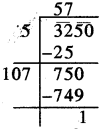
This shows that (57)2 is less than 3250 by 1. So, in order to get a perfect square, 1 must be subtracted from the given number.
∴ Required perfect square number
= 3250 - 1 = 3249
Also, \(\sqrt{3249}\) = 57
(iv) 825
Answer:
First, we try to find the square root of 825
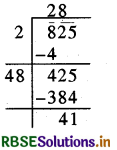
This shows that (28)2 is less than 825 by 41. So, in order to get a perfect square, 41 must be subtracted from die given number.
∴ Required perfect square number
= 825 - 41 = 784
Also, \(\sqrt{784}\) = 28
(v) 4000
Answer:
First, we try to find the square root of 4000.
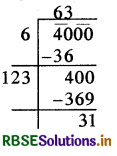
This shows that (63)2 is less than 4000 by 31. So, in order to get a perfect square, 31 must be subtracted from the given number.
∴ Required perfect square number
= 4000 - 31 = 3969
Also, \(\sqrt{3969}\) = 63

Question 5.
Find the least number which must be added to each of the following numbers so as to get a perfect square. Also find the square root of the perfect square so obtained,
(i) 525
Answer:
First, we try to find the square root of 525.
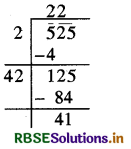
We see that
(22)2 < 525 < (23)2
The required number to be added = (23)2 - 525 = 529 - 525 = 4
∴ Required perfect square number = 525 + 4 = 529
Clearly, \(\sqrt{529}\) = 23
(ii) 1750
Answer:
We try to find the square root of 1750

We observe that (41)2 < 1750 < (42)2.
The required number to be added
= (42)2 - 1750 = 1764 - 1750
= 14
∴ Required perfect square number
= 1750 + 14 = 1764
Clearly, \(\sqrt{1764}\) = 42
(iii) 252
Answer:
We try to find the square root of 252.

We observe that (15)2 < 252 < (16)2
The required number to be added
= (16)2 - 252
= 256 - 252
= 4
∴ Required perfect square number
= 252 + 4 = 256
Clearly, \(\sqrt{256}\) = 16

(iv) 1825
Answer:
We try to find the square root of 1825.
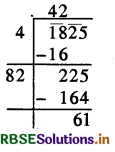
We observe that (42)2 < 1825 < (43)2
The required number to be added = (43)2 - 1825 = 1849 - 1825 = 24.
∴ Required perfect square number
= 1825 + 24 = 1849
Clearly, \(\sqrt{1849}\) = 43
(v) 6412
Answer:
We try to find the square root of 6412
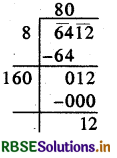
We observe that (80)2 <6412 < (81)2
The required number to be added = (81)2 - 6412
= 6561 - 6412 = 149
Required perfect square number
= 6412 + 149 = 6561
Clearly, \(\sqrt{6561}\) = 81
Question 6.
Find the length of the side of a square whose area is 441 m2
Answer:
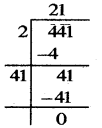
Area = (side)2
= 441 m2
Side = \(\sqrt{441}\) m
= 21 m
Question 7.
In a right triangle ABC, ∠B = 90°.
(a) If AB = 6 cm, BC = 8 cm, find AC
Answer:
In right angled triangle ABC, by Pythagoras theorem,

AC2 = AB2 + BC2
∴ AC2 = 62 + 82
= 36 + 64 = 100
∴ AC = \(\sqrt{100}\) cm = 10 cm
(b) If AC = 13 cm, BC = 5 cm, find AB
Answer:
In right angled triangle ABC, by Pythagoras theorem,
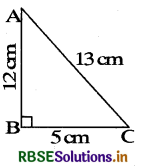
AC2 = AB2 + BC2
or 132 = AB2 + 52
or 169 = AB2 + 25
or AB2 = 169 - 25 = 144
AB = \(\sqrt{144}\) cm = 12 cm

Question 8.
A gardener has 1000 plants. He wants to plant these in such a way that the number of rows and the number of columns remain same. Find the minimum number of plants he needs more for this.
Answer:
First, we try to find out the square root of 1000.
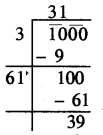
We observe that (31)2 < 1000 < (32)2
This shows that (31)2 is less than 1000 by 39 and (32)2 = 1024.
Thus the gardener needs 1024 - 1000 = 24 plants more to plant in such a way that the number of rows and the number of columns remain the same.
Question 9.
There are 500 children in a school. For a P.T. drill, they have to stand in such a manner that the number of rows is equal to number of columns. How many children would be left out in this arrangement?
Answer:
First, we find the square root of 500.
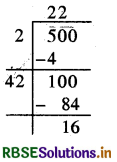
This shows that (22)2 = 484 is less than 500 by 16.
16 students have to go out for others to do the P.T. practice as per condition.
